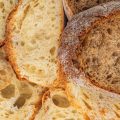Navigating the choppy waters of irritable bowel syndrome (IBS) is no small feat. With dietary adjustments playing a pivotal role in managing symptoms, the quest for gut-friendly foods is constant. Enter sourdough bread – an age-old favorite that’s making a comeback not just for its distinctive tang but also for its potential benefits for those with sensitive bellies. But here’s the burning question for anyone tiptoeing around a low-FODMAP diet: Can you actually enjoy sourdough without triggering a symphony of IBS symptoms?

Table of Contents
- What Is Sourdough?
- Sourdough and the Low FODMAP Diet
- Is All Sourdough Bread Low FODMAP?
- What Sourdough Breads Are Low FODMAP?
- How Do You Choose a Low FODMAP Sourdough Bread?
- What Other Bread Is Low FODMAP?
- Sourdough and Low FODMAP Diets
- Is Sourdough Low FODMAP: FAQs
What Is Sourdough?
Sourdough bread dates back thousands of years, with evidence of its use in ancient Egypt around 1500 BC. Unlike most modern breads that rely on commercial yeast to rise, sourdough utilizes a starter composed of flour and water that has been colonized by wild yeast and bacteria. This starter acts as a natural leavening agent.
The starter must be cared for, and fed fresh flour and water regularly to keep the yeast and bacteria active. As the wild microbes ferment the sugars in the new food, they produce lactic and acetic acids as byproducts. This is what gives sourdough its tangy flavor and enables the bread to rise.
When it comes time to bake, a portion of the mature starter is mixed with more flour and water to make the dough. The yeast cells eat the sugars, producing carbon dioxide bubbles that cause the dough to become light and airy when baked into the classic artisan loaf. The bacteria are also important, creating acids that strengthen the gluten structure and contribute complexity of flavor.
Through the intentional cultivation of wild microbes, sourdough connects us to ancient traditions of breadmaking. Its flavor and rise come not from packaged ingredients but from harnessing invisible forces of nature present in the flour and environment. Sourdough’s soul comes from life itself.
Sourdough and the Low FODMAP Diet
The low FODMAP diet has become a popular way of managing irritable bowel syndrome (IBS) and other digestive issues. It involves limiting the intake of certain carbs that can ferment in the gut and cause gas, bloating, and other unpleasant symptoms.
Bread is one common source of FODMAPs, but sourdough is different. The fermentation process sourdough undergoes can make it easier to digest, potentially making it suitable for a low FODMAP diet.
How Sourdough Fermentation Impacts FODMAPs
During sourdough fermentation, the yeast and bacteria feed on sugars and starches, breaking them down through enzymes and acids. This pre-digests some of the wheat and rye components that contain FODMAPs.
Specific types of FODMAPs that tend to be reduced through extended fermentation include:
- Fructans – chains of fructose carbs
- Galactooligosaccharides (GOS) – chains of galactose carbs
- Mannitol – a 6-carbon sugar alcohol
So even though sourdough is made from wheat or rye, the microbial activity helps create a less gas-producing, gentler option for those sticking to a strict low FODMAP diet.
Additional Factors Impacting Digestibility
Keep in mind sourdough can vary a lot in FODMAP content depending on the:
- Length of fermentation time
- Type of flour used
- Amount of starter culture relative to new flour and water
Using higher percentages of starter and allowing longer rise times tends to make the bread easier to break down for people with sensitivities. Talk to your baker to understand their process.
While sourdough may be low FODMAP compared to other bread options, portion size, and individual tolerance levels also play key roles. It’s best to introduce sourdough slowly and pay attention to any symptoms.
So for those avoiding FODMAPs, artisan-style sourdough baked according to traditional techniques offers a tasty alternative worth trying! The microbial magic at work creates a loaf full of flavor yet easier on the gut.
Try this low FODMAP sourdough bread recipe I have on the blog.
Is All Sourdough Bread Low FODMAP?
A common misconception is that all sourdough bread is low in FODMAPs. However, the reality is more nuanced.
While traditional, long-fermented sourdough tends to be easier to digest, not every loaf marketed as “sourdough” offers the same benefits. Variable ingredients and baking methods impact the final FODMAP content.
As we dig into the details, it becomes clear you can’t judge a bread just by its name. Understanding what creates the potential for low FODMAP sourdough provides clarity.
Sourdough Fermentation Reduces FODMAPs
During extended fermentation, the wild yeast and bacteria in sourdough break down and consume FODMAP carbohydrates. This is what enables well-fermented sourdough to be low-FODMAP compared to other breads. But the duration of the rise plays a key role. Quick sourdoughs don’t reap the full digestive benefits.
Ingredients Impact Carb Content
Added sugars, alternative flours, and various mix-ins can introduce extra FODMAPs not present in a basic sourdough recipe. Check the ingredients list rather than assuming sourdough means low FODMAP. Stick to simple loaves for better odds.
Not All Sourdough Rises Equal
Bakeries aiming for efficiency often underproof their sourdough, failing to allow full fermentation. This results in bread with more residual FODMAPs. Seek out traditionally-crafted loaves made with longer rise times for the lowest FODMAP options.
What Sourdough Breads Are Low FODMAP?
Not all sourdough breads are considered low FODMAP. The amount of fermentation and the ingredients affect the FODMAP content. Knowing what makes sourdough bread low in FODMAPs can help you pick the right options.
Fully Fermented Sourdough
Sourdough that has fermented for at least 8 hours tends to be low FODMAP. During the long rise, the wild yeast eats the FODMAP sugars, making the bread easier to digest. Look for artisan breads made with a very long fermentation time. These provide the low FODMAP benefits of sourdough.
Simple, High-Quality Ingredients
A good sourdough depends on both technique and ingredients. Choose loaves made with just a few basic whole ingredients: flour, water, salt, and a starter. Added sugars, additives, and preservatives can increase FODMAPs. Check the list of ingredients if unsure. A homemade taste usually signals lower FODMAP.
Rye and Spelt Breads
While wheat sourdough can be low FODMAP if well-fermented, rye and spelt versions are extra gut-friendly. The fermentation draws out more FODMAPs from these flours. Enjoy pumpernickel, rye sourdough, or spelt bread without worrying about digestive issues.
How Do You Choose a Low FODMAP Sourdough Bread?
With so many loaves lining bakery shelves, how do ya pick one that won’t kick up symptoms? Let’s break it down.
- First up, read the label. A short ingredient list is ideal – you want to see words like whole wheat flour, water, sea salt, and starter. Long lists with added sugars and preservatives are red flags.
- Next, if a local bakery especially touts its lengthy sourdough fermentation process, inquire further. No “Verified Sourdough” certification like in Europe yet, but artisan bakeries may specially showcase their traditional techniques.
- When baking sourdough at home, opt for whole grains like whole wheat, rye, or sprouted wheat. And let that starter work its magic for a full day – we’re talkin’ 24 hours folks! This draws out more FODMAPs than a quick rise.
- Lastly, start small with just a slice. Even if labeled low FODMAP, every belly is different. Slowly increase portions and pay attention to reactions before gobblin’ a whole loaf.
Choose wisely and soon you’ll be enjoying a warm slice of sourdough without the side of sorrow! Just gotta be a savvy shopper and let that starter do its thing. Then it’s hello yummy carbs and bye-bye tummy rumbles!
What Other Bread Is Low FODMAP?
Beyond sourdough, several tasty bread options tend to be low FODMAP and gentle on sensitive stomachs. These alternatives helps ensure your sandwich stays satisfying while preventing unpleasant digestive symptoms.
Gluten-Free Breads
Gluten-free bread makes smart substitutions, often using grains that are naturally low FODMAP like rice, corn, buckwheat, or quinoa instead of wheat.
Check the labels since some use questionable additives, but high-quality gluten-free breads baked according to traditional techniques work well. Fluffy rice bread and hearty-seed loaves offer lighter alternatives worth trying.
Related: How to Make Gluten Free Sourdough Starter
Spelt and Other Ancient Grains
Bread made from ancient grains like spelt, amaranth, and teff tends to be easier on the system. These wholesome options haven’t been hybridized as intensely as modern wheat, meaning the gluten structure may be gentler. Nutty, dense loaves bake up pleasantly with these ancestral grains. Amazing low fodmap bread!
Seeded and Sprouted Breads
Breads showcasing whole grains, seeds, or sprouted ingredients make nutritious choices. The intact nutrients and fiber aid digestion while providing lasting energy.
Opt for hearty slices packed with flax, sunflower seeds, or millet sprouts over plain white options.
Sourdough and Low FODMAP Diets
The bottom line is this – sourdough that’s been allowed to ferment properly is typically low FODMAP and gentler on sensitive stomachs than other types of bread. This magic happens because the extended fermentation period gives the natural yeast a chance to break down the FODMAP sugars, which are often the culprits behind digestive discomfort. But beware, not all sourdoughs are made equal. Those quick-fix or mass-produced varieties might not bring the same soothing benefits to your table.
For those threading through the low FODMAP maze, your best bet is to reach for sourdough loaves that are traditionally crafted with patience, using simple ingredients and a baker’s lovingly maintained starter. Opt for rye or sprouted grain sourdough for an even kinder touch on your tummy. Remember, moderation is key – start with small portions and monitor how your body responds. And, as the golden rule goes, always loop in your healthcare provider or a dietitian when tweaking your diet for health reasons.
Is Sourdough Low FODMAP: FAQs
Is sourdough bread a low FODMAP?
Yes, properly fermented sourdough bread is considered low FODMAP as the fermentation process breaks down fructans and galactans, making it easier to digest for those with IBS or sensitivities. Stick to one slice per sitting.
Which bread is best for low FODMAP?
Sourdough and yeast-free breads made from gluten-free grains like rice and corn can be great low-FODMAP options, as well as certified gluten-free breads. Check labels for high FODMAP ingredients.
Is sourdough bread good for IBS sufferers?
Yes, the fermentation of sourdough bread breaks down certain carbohydrates that can trigger IBS symptoms. Sourdough is often well tolerated in moderate servings.
Is sourdough good for gut issues?
Sourdough’s prebiotic properties may promote good gut bacteria. Its low FODMAP status and the fermentation process make it easier to digest for those with gut issues like IBS, SIBO, or sensitivities.





